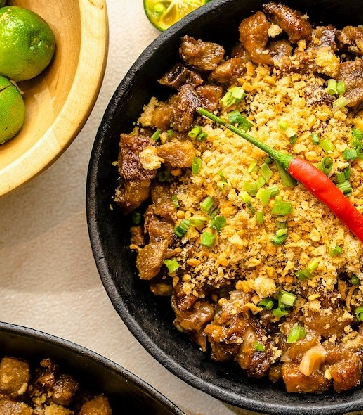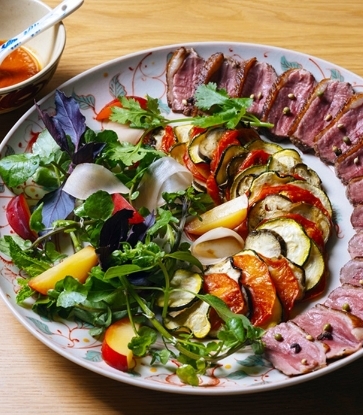Sri Lanka is known for being at a historical crossroads with its myriad of influences, and its cuisine is no exception. The Javanese, Malay, Indian, Arab, Portuguese, Dutch, and British have all left their mark on this island’s culinary landscape. Thanks to its strategic geographical location, Sri Lanka boasts an abundance of coconut milk and oil, a bounty of seafood from its shallow lagoon waters, and a nod to southern Indian flavours with staples like dahl.
And this is the Sri-Lankan story that Kotuwa, a Sri Lankan Bib Gourmand restaurant in Singapore, wants to tell through its food. With chef-owner Rishi Naleendra at the helm, Kotuwa’s dishes pay homage to his Sri Lankan heritage through his unique spin on traditional dishes, while keeping it local and ingredient-driven. Originally from Colombo, Naleendra’s cuisine seamlessly blends his Sri Lankan roots with the influences of his culinary journey in Australia, including his past venture, Cheek by Jowl, and the current two-MICHELIN-Starred Cloudstreet.
Today, Naleendra shares with us the different types of curries at Kotuwa, how to best complement them, and his personal favourite among the offerings.

Coconut Milk Based Curries
Distinguishing Sri Lankan curries from their Indian counterparts is the predominant use of coconut — be it in the form of oil, milk, or flesh. Emphasising fresh ingredients like pandan leaves and lemongrass over dry spice powders, Sri Lankan curries boast a lighter and more refreshing profile. Kotuwa’s Amba Curry, for instance, features tangy green mangoes cooked with turmeric and velvety coconut cream.

Devilled Curries
Devilled curries, a subtype of dry curries in Sri Lanka, draw inspiration from the sweet, spicy, and tangy flavours reminiscent of Chinese stir-fry dishes. Known for their bold spiciness, these curries feature ingredients like chilli, garlic, ginger, soy sauce, and vinegar. They are commonly prepared with meat or seafood, and the stir-frying technique is frequently used to achieve a quick and flavourful result. At Kotuwa, devilled prawns are stir-fried with ginger, green chilli, and tomatoes.

Red Curries
Red curries in Sri Lanka derive their vibrant hue and spiciness primarily from the red chilli. While the addition of tomatoes is not obligatory, they are occasionally included to enhance flavour and texture. Naleendra’s approach to Kotuwa’s lamb curry incorporates tomatoes, emphasising their acidity and mild sweetness as a harmonious complement to the protein, creating a “lighter” curry experience.

Jaffna-style Curry
Situated at the northern tip of the island, Jaffna boasts a community predominantly of Tamil descent, imparting a distinct influence on its culinary traditions. Reflecting this heritage, Jaffna-style curries are characterised by their red hue, owing to the generous use of chilli powder, resulting in curries that are notably spicier and possess a fuller body. At Kotuwa, Naleendra matches the choice of protein with the spices they use instead of the gravy. For example, duck goes well with Jaffna spices, hence they have it in a Jaffna curry that is spicier.

Dahl
Sri Lankan dahl, also known as parippu or dal, is a well-loved staple influenced by the culinary traditions of Southern India due to historical and geographical ties. The core ingredients used in Sri Lankan dahl, such as lentils (usually red lentils), coconut, and various spices are commonly found in Southern Indian cuisine as well. However, the use of Maldive fish or pandan leaves, for example, can add distinct flavours to Sri Lankan dahl.
Dahl is Naleendra’s personal favourite. He reminisces, “it’s my comfort food and it reminds me of home.” The dahl at Kotuwa, made with red lentils and tempered black mustard, pays homage to his mother’s recipe.
How to Enhance the Curry Experience
Sri Lankan cuisine is best enjoyed generously and as a combination of multiple types of dishes. Sri Lankans usually try to have a balanced spread of a few different kinds of curries (wet and dry) with yellow rice, dhal, hoppers, different sambols, and achcharus.
Hoppers, also known as appam, are great with any curry. This traditional Sri Lankan dish takes the form of a thin, bowl-shaped pancake made from a batter of fermented rice flour, coconut milk, and a touch of coconut water. Varieties include plain hoppers, egg hoppers, and string hoppers (idiyappam), the latter featuring batter pressed into noodle-like strands. String hoppers are almost always enjoyed with curries.

Condiments also play a crucial role in balancing the meal. For instance, the renowned Sri Lankan crab curry (pictured in the header image) is best paired with pol sambol — a spicy and zesty condiment combining freshly shredded coconut, chilli, and hints of lime. According to Naleendra, this is the perfect complement to a spread of rice, hopper and curries to add a touch of brightness to your meal.

Of course, these curries represent only a glimpse of the diverse culinary landscape in Sri Lanka. Dispelling the misconception that Sri Lankan cuisine is solely defined by curries, Naleendra (pictured on the right) highlights the diverse array of non-curry dishes his home country has to offer.
From sautéed fresh leafy greens (mallung) to “short-eats” and Dutch-Burgher influenced Lamprais, there are still a lot of culinary treasures left for us to explore.
Photos are all courtesy of Kotuwa.
Kotuwa is located at Wanderlust Hotel, Level 1, 2 Dickson Road, 209494, Singapore. Book a table here.






















